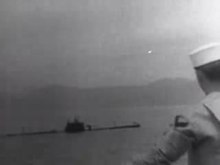Brazilian Expeditionary Force
| Brazilian Expeditionary Force | |
|---|---|
| Força Expedicionária Brasileira | |
 Brazilian Expeditionary Force shoulder sleeve insignia (Army component) with a
smoking snake | |
| Active | 1942–1945 |
| Country | |
| Allegiance | United Nations |
| Branch | Brazilian Army Brazilian Air Force |
| Type | Expeditionary Force |
| Role | Aerial warfare Combined arms Expeditionary warfare Jungle warfare |
| Size | 25,900 |
| Nickname(s) | Cobras Fumantes (Smoking Snakes) |
| Patron | The Duke of Caxias |
| Engagements | World War II
|
| Commanders | |
| Notable commanders | Mascarenhas de Moraes |
| History of Brazil |
|---|
 |
|
|
The Brazilian Expeditionary Force (Portuguese: Força Expedicionária Brasileira, FEB) consisted of about 25,900 men arranged by the army and air force to fight alongside the Allied forces in the Mediterranean Theatre of World War II. This air–land force consisted of (replacements included) a complete infantry division, a liaison flight, and a fighter squadron.[1]
It fought in Italy from September 1944 to May 1945, while the Brazilian Navy as well as the Air Force also acted in the Battle of the Atlantic from the middle of 1942 until the end of the war. During the almost eight months of its campaign, fighting at the Gothic Line and in the 1945 final offensive, the FEB took 20,573 Axis prisoners, consisting of two generals, 892 officers, and 19,679 other ranks. Brazil was the only independent South American country to send ground troops to fight overseas during the Second World War, losing 948 men killed in action across all three services.[2][1]
Overview[]
Brazil's participation alongside the Allied powers in World War II was not a foregone conclusion. In World War I, Brazil had supported the Triple Entente, along with Japan and Romania. In 1917–1918, Brazil's participation was primarily naval, although it also sent a military mission to the Western Front.
As in 1914, Brazil in 1939 maintained a position of neutrality, initially trading with both the Allies and the Axis powers. As the war progressed, trade with the Axis countries became almost impossible and the US began forceful diplomatic and economic efforts to bring Brazil onto the Allied side. These efforts led to the creation of the Joint Brazil-US Defense Commission, which was chaired by James Garesche Ord. It worked to strengthen military ties between Brazil and the US during the war. It was designed to reduce the likelihood of Axis attacks on US shipping, as soldiers traveled across the Atlantic to Africa and Europe, and minimized the influence of the Axis in South America.[3]
At the beginning of 1942, Brazil permitted the US to set up air bases on its territory in return for the offer by the US to encourage the formation of a steel industry - Companhia Siderúrgica Nacional, in Brazil. The US bases were located in the states of Bahia, Pernambuco and Rio Grande do Norte, where the city of Natal hosted part of the US Navy's VP-52. In addition, US Task Force 3 established itself in Brazil. This included a squadron equipped to attack submarines and merchant vessels attempting to trade with Japan.
Although Brazil remained neutral, this increasing cooperation with the Allies led the Brazilian government to announce at the Pan American States Conference in Rio, on 28 January 1942, its decision to sever diplomatic relations with Germany, Japan, and Italy.
As a result, from the end of January to July 1942, although no declaration of war yet existed between Germany and Brazil, German U-boats sank 13 Brazilian merchant vessels. In August 1942, U-507 alone sank five Brazilian vessels in two days, causing more than 600 deaths:[4]
- On August 15, the Baependi, traveling from Salvador to Recife, was torpedoed at 19:12. Its 215 passengers and 55 crew members were lost.
- At 21:03, U-507 torpedoed the Araraquara, also traveling from Salvador towards the north of the country. Of the 142 people on board, 131 died.
- Seven hours after the second attack, U-507 attacked the Anníbal Benévolo. All 83 passengers died; of a crew of 71, four survived.
- On August 17, close to the city of Vitória, the Itagiba was hit at 10:45, with a death toll of 36.
- Another Brazilian ship, the Arará, traveling from Salvador to Santos, stopped to help the crippled Itagiba, but ended up as the fifth Brazilian victim of the German submarine, with a death toll of 20.
In all, 21 German and 2 Italian submarines caused the sinking of 36 Brazilian merchant ships involving 1,691 drownings and 1,079 other casualties. The sinkings led to a declaration of war against the Axis.
Berlin Radio pronouncements led to increasing nervousness among the Brazilian population. So, in 1942, unlike in 1917, it seemed that the Brazilian government did not want war. In some cities like Rio de Janeiro, the people started to protest against neutrality. This included some harassment of German communities.[5] The passive position of the Vargas government proved untenable in the face of public opinion. Ultimately, the government found itself with no alternative but to declare war on Germany and Italy on August 22, 1942.

The decision regarding the creation of the FEB came after the Potenji River Conference, a meeting between President Franklin D. Roosevelt and Getulio Vargas, which was held in Natal, Rio Grande do Norte aboard USS Humboldt. This Conference took place on 28 and 29 January 1943, right after the Casablanca Conference in Morocco, which President Roosevelt also attended.
[]
The participation of the Brazilian Navy in World War II was not directly connected to the FEB and the Italian Campaign, having been largely engaged in the Battle of the Atlantic. As a result of the Axis attacks, Brazil suffered nearly 1,600 dead, including almost 500 civilians and more than 1,000 of Brazil's 7,000 sailors involved in the conflict. The naval losses included 470 sailors of the merchant marine and 570 sailors of the Navy, a total of 36 ships sunk by the Germans, and more than 350 dead in three accidental sinkings.[6]
The main task of the Brazilian Navy was, together with the Allies, to ensure the safety of ships sailing between the Central and South Atlantic to Gibraltar. Alone or in coordination with Allied forces, it escorted 614 convoys that protected 3,164 merchant and transport troop ships;[7] In the battle against German submarines, Brazilian frigates and submarines used mines and depth charges. According to German documents, the Brazilian Navy attacked German submarines a total of 66 times.
Along the Brazilian coast, the destruction of twelve Axis submarines (one Italian and eleven German) has been verified: Italian submarine Archimede, U-128, U-161, U-164, U-199, U-507, U-513, U-590, U-591, U-598, U-604 and U-662.[8][9][10]
Among the warships lost by the Brazilian navy, were the minelayer BZ Camaqua, which capsized during a storm while escorting a convoy in July 1944, and the light cruiser BZ Bahia due to a gunnery accident.[11][12] The majority of the crew of the Bahia were lost.[13] Of the three Brazilian military ships lost during the war, only the freighter-troopship Vital de Oliveira was due to the action of an enemy submarine, being sunk by the U-861 on July 20, 1944.[14]
Brazilian fleet during World War II[]
| Class | Boat | Displacement | Type | Origin | Note | Photo |
|---|---|---|---|---|---|---|
| Minas Geraes-class battleship | Minas Geraes São Paulo |
20,900 tons | Battleship Dreadnought | 
| ||
| Bahia-class cruiser | Bahia Rio Grande do Sul |
3,100 tonnes | Scout cruiser | 
| ||
| Marcílio Dias-class destroyer | M1 Marcílio Dias M2 Mariz e Barros M3 Greenhalgh |
1,900 tonnes | Destroyer | 
| ||
| Acasta-class destroyer | Maranhão | 950 tonnes | Destroyer | 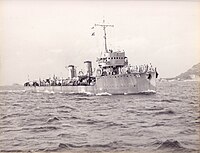
| ||
| Pará-class destroyer | Piauí Mato Grosso Rio Grande do Norte Paraíba Santa Catarina Sergipe |
570 tonnes | Destroyer | 
| ||
| Cannon-class destroyer | Babitonga Baependi Benevente Beberibe Bocaina Bauru Bertioga Bracui |
1,500 tonnes | Destroyer escort | 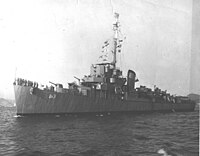
| ||
| Carioca-class Corvette | C1 Carioca C2 Cananéia C3 Camocim C4 Cabedelo C5 Caravelas C6 Camaquã |
818 tonnes | Corvette | 
| ||
| Pernambuco-class Monitor | Pernambuco Paraguassú |
650 tonnes | Gunboat | 
| ||
| PC461-class submarine chaser | G1 Guaporé G2 Gurupi G3 Guaíba G4 Guarupá G5 Guajará G6 Goiânia G7 Grajaú G8 Graúna |
450 tonnes | Submarine chaser/Patrol Boat | 
| ||
| Tupy class submarine | S11 Tupy S12 Tymbira S13 Tamoyo |
1,450 tonnes | Submarine | |||
| Humayta-class submarine | Humaytá | 1,900 tonnes | Submarine | 
|
Command[]

The Brazilian 1st Division of the FEB was subordinate to the Allied 15th Army Group under Field Marshal Harold Alexander (later succeeded by General Mark Clark), via the US Fifth Army of Lieutenant General Mark Clark (later succeeded by Lieutenant General Lucian Truscott) and the US IV Corps of Major General Willis D. Crittenberger. The entry for the Gothic Line order of battle provides the layout for the Allied and German armies in Italy.
The FEB headquarters functioned as an administrative headquarters and link to the Brazilian high command under the secretary of war, General Eurico Gaspar Dutra in Rio de Janeiro. General Mascarenhas de Morais (later marshal) was the commander of the FEB, with General Zenóbio da Costa as chief of the 6th Regimental Combat Team (RCT) of Caçapava (the first FEB RCT to land in Italy), and General Cordeiro de Farias as commander of artillery.
The FEB was (theoretically) organized as a standard US infantry division of that time, complete in all aspects, down to its logistical tail (including postal and banking services), although some of these, like its health services, were found to be deficient and had to be complemented, and in many cases controlled or managed by Americans.[15][16] Its combat units were, besides the aforementioned 6th RCT, the 1st RCT based in Rio de Janeiro, and the 11th from São João del Rey. Each RCT had about 5,000 men (corresponding in size to today brigades), divided in three then called "battalions" consisting of four companies each, including supporting units for combat, and other army branches, like artillery, engineering, and cavalry.[17] The Brazilian Air Force Fighter squadron was itself under the Mediterranean Allied Tactical Air Force.[18]
Campaign[]
Preparations[]
Soon after Brazil declared war on the Axis, it began a popular mobilization for an expeditionary force to fight in Europe.[19][20] At that time, Brazil was a country with a traditionally isolationist foreign policy. Its population was largely rural and illiterate, its economy focused on exporting commodities, and it lacked infrastructure in industry, health care, and education, which was needed to support the war effort with material and human resources. Further, an action plan to circumvent these limitations (like the Calogeras Plan of the previous World War) was out of the question because many Brazilian military officers believed that a Nazi-Fascist defeat in Europe would increase demands for democracy within Brazil. At the time, Brazil had a military regime. It had been openly authoritarian from 1937 and sympathetic to Nazi-fascist regimes until 1941. Brazil was thus precluded from pursuing a line of autonomous action in the conflict, and found it difficult to take even a modest role in it.
Faced with the government's passivity and unwillingness, Assis Chateaubriand, a mass media magnate, negotiated with US officials stationed in Brazil, for the creation of an expeditionary army division, composed of volunteers from all of Latin America. This division would be financed by him, led by a Brazilian general, and trained by American officials. This initiative was curtailed by the Brazilian government in early 1943.[21]
Almost two years later, Brazil officially entered the war and sent troops to the European Theater of Operations. For comparison, the gap between the US's entrance and Operation Torch was almost one year. Several reasons contributed to the delay: political distrust between the Brazilian and American authorities, disagreements over the target size of the Brazilian Expeditionary Force, differences between Brazilian aspirations and American preferences for controlling the force, and disagreements on whether it should be fully trained and armed before boarding or get stationed behind the Italian Front and train there;[22]
In the end, the Brazilian government gathered a force of one Army Division of 25,000 men (replacements included), compared with an initial declared goal of a whole Army Corps of 100,000, to join the Allies in the Italian Campaign.[23]
Arrival in Italy[]
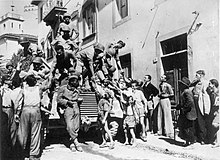
On July 2, 1944, the first five thousand FEB soldiers, the 6th RCT, left Brazil for Europe aboard the USS General Mann, and arrived in Italy on July 16. They disembarked in Naples, where they waited to join the US Task Force 45. They had landed without weapons, and since there was no arrangement for barracks, the troops remained on the docks. This caused controversy in the Brazilian media.[24] In late July, two more transports with Brazilian troops reached Italy, with three more following in September and November 1944, and February 1945. One notable unit deployed was Brazil's Mountain Infantry Battalion.
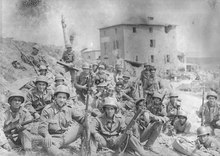
The FEB dedicated its first weeks in Italy to acquiring the proper equipment to fight on Italian terrain, and to training under American command.[25] The preparation in Brazil, despite the two years' interval since the declaration of war, had proved almost worthless. Among the veterans of that campaign, there was a consensus that only combat could adequately prepare the soldier, regardless of the quality of training received earlier.[26][27] In August, the troops moved to Tarquinia, 350 km north of Naples, where Clark's army was based. In November, the FEB joined General Crittenberger's US IV Corps.
The Brazilians joined what was a multinational hodgepodge of forces. The American forces included the segregated African-American 92nd Infantry Division and the Japanese-American 442nd Infantry Regiment. British Empire forces included New Zealanders, Canadians, Indians, Gurkhas, Black Africans, Jews and Arabs from the British Mandate in Palestine, South Africans and Rhodesians, units of exiles—Poles, Greeks, Czechs, Slovaks, as well as anti-fascist Italians, all serving under British command. French forces included Senegalese, Moroccans and Algerians.[28][29][30]
The Germans made much of the political aspect of the presence of the Brazilian force in Italy. They targeted propaganda specifically at the Brazilians.[31] In addition to leaflets, the Germans provided an hour-long daily radio broadcast (in Portuguese) from Berlin Radio called "Hora AuriVerde" (GoldenGreen Hour).
Combat[]
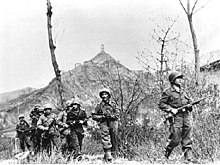

The FEB achieved battlefield successes at Massarosa, Camaiore, Mount Prano, Monte Acuto, San Quirico, Gallicano, Barga, Monte Castello, La Serra, Castelnuovo di Vergato, Soprassasso, Montese, Paravento, Zocca, Marano sul Panaro, Collecchio and Fornovo di Taro.[32]

The first missions the Brazilians undertook in close connection with the US 370th RCT, were reconnaissance operations to the end of August. Brazilian troops helped to partially fill the gap left by divisions of the US VI Corps and French Expeditionary Corps that left Italy for Operation Dragoon, the invasion of southern France. On September 16, the 6th RCT took Massarosa. Two days later it also took Camaiore and other small towns on the way north. By then, the FEB had already conquered Monte Prano, and taken control of the Serchio valley without any major casualties. After having suffered its first reverses around Barga city, and after the arrival of the 1st RCT at the end of October, the FEB was directed to the base of the Northern Apennines, on the border between Tuscany and Emilia-Romagna regions, where it would spend the next months facing the harsh winter and the resistance of the Gothic Line.[33] Allied forces were unable to break through the mountains over the winter and an offensive by German and Italian divisions to the left of the FEB sector, against the US 92nd Infantry Division, required the assistance of the 8th Indian Infantry Division before it was repelled.
Between the end of February and the beginning of March 1945, in preparation for the Spring offensive, the Brazilian Division and the US 10th Mountain Division were able to capture important positions on the Northern Apennines (noteworthy in the Brazilian sector, for Monte Castello and Castelnuovo), which deprived the Germans of key artillery positions in the mountains, whose effective fire had since the fall of 1944 blocked the Allied path to Bologna.[34][35][36]
In the US Fifth Army's sector, the final offensive on the Italian Front began on April 14, after a bombardment of 2,000 artillery pieces; an attack carried out by the troops of US IV Corps led by the Brazilian Division took Montese. After the first day of the Allied offensive, the Germans, without much effort, had stopped the main attack of IV Corps led by the US 10th Mountain Division, causing significant casualties among the troops of that formation. The Germans were misled into thinking that the FEB's raid over Montese, using M8 armoured cars and Sherman Tanks, could be the real main Allied objective in that sector, which led them to shell the Brazilians with 1,800 artillery rounds from the total of 2,800 used against all four Allied divisions in that sector during the days of the battle for Montese,[37] when they tried unsuccessfully to take Montese back from the Brazilians. After that, the breaking of the Germans' lines to the North by forces of IV Corps became unavoidable.[38] On the right, the Polish Division, from the British 8th Army, and the US 34th Infantry Division, from Fifth Army, entered Bologna on 21 April.
On 25 April the Italian resistance movement started a general partisan insurrection at the same time as Brazilian troops arrived at Parma and the Americans at Modena and Genoa. The British 8th Army advanced towards Venice and Trieste.
At the Battle of Collecchio, Brazilian forces were preparing to face fierce resistance at the Taro river region from the retreating German-Italian forces in the region of Genoa/La Spezia that had been set free by troops of the 92nd US Division. These Axis troops were enveloped near Fornovo and after some fighting surrendered. On April 28, the Brazilians captured more than 13,000 men, including the entire 148th Infantry Division, elements of the 90th Panzergrenadier and the Italian 1st Bersaglieri "Italia" Division.[citation needed]
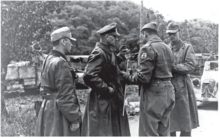
This took the German Command by surprise as it had planned for these troops to join forces with the German-Italian Army of Liguria to counterattack against the Fifth Army. Fifth Army had advanced, as is inevitable in these situations, in a fast but diffuse and disarranged way uncoordinated with air support, and had left some gaps on its left flank and to the rear. The Axis forces had left many bridges intact along the Po River to facilitate a counter-attack. German Army Command was already negotiating a truce in Caserta, and hoped that a counterattack would improve the conditions for surrender. The events in Fornovo disrupted the German plan, as much by the disarray of their troops as by the delay it caused.[39] This, added to the news of Adolf Hitler's death and the taking of Berlin by the Red Army, left the German Command in Italy with no option but to accept the demand for the unconditional surrender of its troops.
In their final advance, the Brazilians reached Turin and then on 2 May they joined up with French troops at the border in Susa. That same day brought the announcement of the end of hostilities in Italy.
Air force[]
1st Fighter Squadron[]
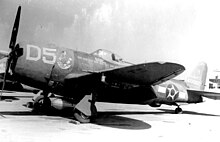


The 1st Fighter Aviation Group (1oGAVCA, 1st Fighter Squadron/1º Grupo de Aviação de Caça) was formed on December 18, 1943. Its commanding Officer was Ten.-Cel.-Av. (Aviation Lieutenant Colonel) Nero Moura. The Squadron had 350 men, including 48 pilots. It was divided into four flights: Red ("A"), Yellow ("B"), Blue ("C"), and Green ("D"). Unlike the FEB's Army component, the 1oGAVCA had personnel who were experienced Brazilian Air Force (Portuguese: Força Aérea Brasileira, or FAB) pilots. One of them was Alberto M. Torres, who commanded the PBY-5A Catalina that had sunk U-199 (which had been operating off the Brazilian coast).[40]
Among the 48 pilots of the Brazilian Unit who carried out war missions, there was a total of 22 losses; five of the pilots were killed by anti-aircraft fire, eight had their planes shot down and bailed out over enemy territory, six had to give up flying operations on medical orders and three died in flying accidents.
The squadron trained for combat at U.S. bases in Panama, where 2o Ten.-Av. (Aviation Second Lieutenant) Dante Isidoro Gastaldoni was killed in a training accident. On May 11, 1944, the squadron was declared operational and became active in the air defense of the Panama Canal Zone. On June 22, the 1oGAVCA traveled to the US to convert to the Republic P-47D Thunderbolt.[41]

On September 19, 1944 the 1oGAVCA left for Italy, arriving at Livorno on October 6.[41] Since the "Group" arrived at the front with the Minimum Limit Number of pilots for an Air Group, and there was no prediction of replacements arrival in a forthcoming future, it was attached as a Squadron at the 350th Fighter Group of the USAAF, which in turn was part of the 62nd Fighter Wing of the 12th Air Force, into the XXII Tactical Air Command.[42][43]
The Brazilian pilots initially flew from 31 October 1944, as individual elements of flights attached to 350th FG squadrons, at first in affiliation flights and progressively taking part in more dangerous missions. Less than two weeks later, on November 11, the Brazilian Squadron started its own operations flying from its base at Tarquinia, using its tactical callsign Jambock. Brazilian Air Force stars replaced the white US star in the roundel on the FAB Thunderbolts. The 1oGAVCA started its fighting career as a fighter-bomber unit, its missions being armed reconnaissance and interdiction, in support of the US Fifth Army, to which the FEB was attached. On April 16, 1945, the US Fifth Army started its offensive along the Po Valley. By then, the strength of the "Group" had fallen to the standard size of an air squadron: 23 pilots, since some had been killed, others shot down and captured, while others had been relieved from their duties on medical grounds due to wounds or combat fatigue.[44]
On 22 April 1945, the three remaining flights took off at 5-minute intervals, starting at 8:30 AM, to destroy bridges, barges, and motorized vehicles in the San Benedetto region. At 10:00 AM, a flight took off for an armed reconnaissance mission south of Mantua. They destroyed more than 80 German military vehicles, including tanks. By the end of the day, the Brazilian Squadron had flown 44 individual missions and destroyed a high number of vehicles and barges. On this day Brazilians flew the most sorties of the war; consequently, Brazil commemorates April 22 as 'Brazilian Fighter Arm' Day. The 1st Brazilian Fighter Squadron accomplished 445 missions, with a total of 2,546 flights and 5,465 hours of flight on active service. It destroyed 1,304 motor-vehicles, 13 railway waggons, 8 armoured cars, 25 railway and highway bridges and 31 fuel tanks and munition depots.
In all, the 1oGAVCA flew a total of 445 missions, 2,550 individual sorties, and 5,465 combat flight hours, from November 11, 1944 to May 6, 1945. The XXII Tactical Air Command acknowledged the efficiency of the Brazilian Squadron by noting that although it flew only 5% of the total of missions carried out by all squadrons under its control, it accomplished a much higher percentage of the total destruction wrought:
- 85% of the ammunition depots
- 36% of the fuel depots
- 28% of the bridges (19% damaged)
- 15% of motor vehicles (13% damaged)
- 10% of horse-drawn vehicles (10% damaged)[45]
Total of operations of the First Brazilian Fighter Squadron in the Italy Campaign:
| Missions accomplished | 445 |
| Offensive missions | 2,546 |
| Defensive missions | 4 |
| Hours of flight in war operations | 5,465 |
| Total hours of flight accomplished | 6,144 |
| Total Bombs dropped | 4,442 |
| Incendiary Bombs (F.T.I) | 166 |
| Fragmentation Bombs (260 lbs) | 16 |
| Fragmentation Bombs (90 lbs) | 72 |
| Demolition Bombs (1.000 lbs) | 8 |
| Demolition Bombs (500 lbs) | 4,180 |
| Approximate total tonnage of bombs | 1,010 |
| Rounds of .50 caliber ammunition fired | 1,180,200 |
| Total rockets fired | 850 |
| Liters of gasoline consumed | 4,058,651 |
| Targets/Objectives | Destroyed | Damaged |
|---|---|---|
| Railway engines | 01 | 13 |
| Motorized transport | 470 | 303 |
| Railway and tank cars | 63 | 163 |
| Armored cars | 07 | 11 |
| Animal drawn vehicles | 79 | 19 |
| Railway and highway bridges | 04 | 14 |
| Railway and highway cuttings | 55 | 00 |
| Buildings occupied by the enemy | 129 | 92 |
| Camps occupied by the enemy | 18 | 14 |
| Command posts | 02 | 02 |
| Artillery positions | 43 | 07 |
| Factories | 04 | 03 |
| Miscellaneous buildings | 39 | 04 |
| Fuel depots | 06 | 02 |
| Refineries | 01 | 01 |
| Radar stations | 00 | 02 |
On April 22, 1986, the 1st Fighter "Group" of the Brazilian Air Force was awarded the United States Presidential Unit Citation for its actions in the Po Valley region of Italy in World War II.[46]
Liaison & Observer Flight[]
The fighter squadron participated in several actions in support of the Brazilian army division yet was not subject to its command. In contrast, the 1st E.L.O. (a Portuguese acronym for 1st "Liaison & Observer Flight") was directly under the command of the Brazilian division.[47]
Formed in late July 1944, the 1st E.L.O. consisted of reservist officers - Air Force pilots and Army artillery observers, who flew together aboard Piper L-4H Cubs. This air unit accompanied the Brazilian division throughout its Italian campaign.[42]
Aftermath[]

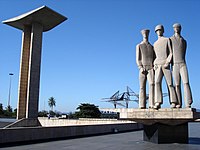
While the Brazilian division still worked in the post-war occupation of the provinces of Piacenza, Lodi and Alessandria, in early June 1945 the Brazilian Secretary of War ordered the FEB's units should stay subordinate to the commander of the first military region, based in the city of then capital Rio de Janeiro, which ultimately meant the dissolution of the Expeditionary Division, which was sent back to Brazil along the second half of 1945.[48]
The bodies of the soldiers buried in the FEB cemetery in Pistoia were later transferred to a mausoleum in Rio de Janeiro. Marshal Mascarenhas de Moraes had proposed and promoted the construction of the mausoleum and it was inaugurated on July 24, 1960. It covers an area of 6,850 square meters.
Brazil's participation in World War II was more extensive than its participation in the previous World War. While the main Brazilian military contribution occurred in the South Atlantic campaign, sending a ground force overseas had more political and social visibility. The Brazilian division was one of about 30 Allied military formations (20 divisions and 10 brigades) on the Italian Front at that time. Although the division played an important part in the sectors in which it operated, none of these were the main sector on that Front (which was, after the German retreat to the north of Rome, the East of the country near to the Adriatic Sea, under the responsibility of the British 8th Army). Furthermore, the Italian Front became secondary for both sides after D-Day and the invasion of Southern France.
Nickname[]

Due to the Brazilian regime's unwillingness to get more deeply involved in the Allied war effort, by early 1943 a popular saying was: "It's more likely for a snake to smoke a pipe than for the FEB to go the front and fight." ("Mais fácil uma cobra fumar um cachimbo, do que a FEB embarcar para o combate.").[49] Before the FEB entered combat, the expression "a cobra vai fumar" ("the snake will smoke") was often used in Brazil in a context similar to "when pigs fly". As a result, the soldiers of the FEB called themselves Cobras Fumantes (literally, Smoking Snakes) and wore a divisional shoulder patch that showed a snake smoking a pipe. It was also common for Brazilian soldiers to write on their mortars, "The Snake is smoking ..." ("A cobra está fumando...").[citation needed] After the war the meaning was reversed, signifying that something will definitively happen and in a furious and aggressive way. With that second meaning the use of the expression "a cobra vai fumar" has been retained in Brazilian Portuguese until the present, although few of the younger generations realize the origin of the expression[citation needed].
See also[]
- Atlantic naval campaign (World War II)
- Brazil at War – American propaganda film about the Brazilian contribution.
- Battle of Monte Castello
- Battle of Collecchio
- Brazil during World War I
- Elza Medeiros – a Brazilian major, she was the highest-ranking female officer in the FEB.
- Max Wolff – A Brazilian war hero from the FEB.
Notes[]
- ^ Jump up to: a b Ibidem Maximiano, Bonalume, Ricardo N. & Bujeiro, 2011.
- ^ Frank D. MacCann – 'Estudios Interdisciplinarios de America Latina y el Caribe', vol. 6, No. 2, 1995.
- ^ Stetson Conn, Byron Fairchild, Office of the Chief of Military History, Department of the Army, The Framework of Hemisphere Defense, 1960, page 319
- ^ VEJA Edição Especial – O Brasil na Guerra Archived December 5, 2013, at the Wayback Machine
- ^ Hélio Silva, "1942 Guerra no Continente"
- ^ Relação de navios brasileiros afundados[permanent dead link]
- ^ Votaw: 1950, page 10579ff. 1951, page 93.
- ^ Heden, 2006. Pages: 58 (6, Wed.), 59 (13, Wed.), 64 (15, Thu.), 66 (17, Mon.), 70 (9, Fri.), 72-73 (19, Mon), 74 (30, Fri. and 31, Sat.); Chapters 6 (German Submarine Losses) & 7 (Italian Submarine Losses).
- ^ Several, James L. Page 17, section "1.16.5 Brazil".
- ^ Barone, 2013. Chapter 2 (final).
- ^ "Allied War Losses". u-boat.net. Retrieved May 20, 2015.
- ^ Bonalume, 1995. Page 216.
- ^ "BZ Bahia (C 12)". u-boat.net. Retrieved May 20, 2015.
- ^ Rohwer, 1999. p.183.
- ^ Several authors, 1949. Pages 294; 394; 414–15.
- ^ Due to the strong sexism in Brazilian society at that time, the participation of women in the FEB was not viewed favorably by the authorities, being discouraged officially and unofficially, even behind the lines in logistics services, in key sectors such as military nursing. In this area there was a boycott attempt, not only by male Brazilian military doctors, but also by women who were in a position of influence in national politics; See Moser, 2009, Page 141.
- ^ Concerning the cavalry, it is important to highlight that this Army branch (whether in the form of larger formations, such as Army divisions Or smaller – as in the case of FEB, small supporting units attached to infantry divisions), in all armies during that conflict, was not restricted to its heavy mechanized use, as with armored cars and tanks. Not only, but especially in mountainous terrain, as was mostly the Italian front, the use of animals, such as the mule (among others) and smaller vehicles like military bicycles and motorcycles, were critical to the mobility of troops. More on this topic can be seen in: Nafziger 2000, and Worley 2006 (Page 85).
- ^ Maximiano, Bonalume & Bujeiro 2011. Page 36
- ^ Fernando Morais; "Chatô, rei do Brasil" (Chatô, the 'king' of Brazil) (in Portuguese) Cia das Letras, 1994 ISBN 8571643962
- ^ Silva, Hélio, "1944 o Brasil na Guerra"
- ^ Ibidem Morais 1994, pp. 431 to 434
- ^ Lochery, 2014. Parts 4 and 5; Chapters 12-16.
- ^ "The United States News" U.S. News Publishing Corporation, 1944. Volume 16, Issues 14–26 – Page 52
- ^ Command Magazine issue 51, page 34
- ^ Frank Marcio de Oliveira "Attaché Extraordinaire: Vernon A. Walters in Brazil" National Defense Intelligence College 2009 ISBN 9781932946222 page 10, 2nd paragraph
- ^ Maximiano, 2010. Chapter 5, pg 222 to 1st paragraph of page 223
- ^ About the same subject, see also: Dave Grossman. "On Killing" & On Combat, as well as Ishmael Beah "A Long Way Gone: Memoirs of a Boy Soldier" from his "enlistment" on page 105 to his formal ending of combat detoxification, page 181
- ^ Corrigan, Gordon "The Second World War" Thomas Dunne Books, 2011 ISBN 9780312577094 Page 523
- ^ Ready, J.Lee, "Forgotten Allies: The European theatre" McFarland, 1985 ISBN 089950129X Pages 152–53, 438.
- ^ O'Reilly, Charles T. "Forgotten Battles: Italy's War of Liberation, 1943–1945" Lexington Books 2001 ISBN 0739101951 Page 118, 3rd §
- ^ "Propaganda leaflets of World War 2: Italian theater of operations/Po Valley Campaign". Archived from the original on April 29, 2018. Retrieved November 8, 2014.
- ^ Edwards, 2010. Page 89.
- ^ R.Brooks, The War North of Rome, p.220 to 224
- ^ Baumgardner, 1998. Pages 26 to 32.
- ^ Bohmler, 1964. End of Chapter IX
- ^ Clark, 1950/2007, p.608
- ^ Dennison de Oliveira, "Os soldados alemães de Vargas" Portuguese [ Germans against Hitler; "The German soldiers of Vargas" ] 1st Chapter, Jurua print. 2008 ISBN 85-362-2076-7
- ^ Willis D. Crittenberger "The final campaign across Italy"; 1952 ISBN 85-7011-219-X
- ^ Ibidem. Bohmler, 1964.
- ^ Ibidem Maximiano, Bonalume & Bujeiro 2011. P. 35-36.
- ^ Jump up to: a b Dias de Cunha, Rudnei. "Republic P-47 Thunderbolt". www.rudnei.cunha.nom.br. Retrieved February 23, 2019.
- ^ Jump up to: a b Ibidem Maximiano, Bonalume & Bujeiro 2011.
- ^ Buyers, 2004. P.98-99.
- ^ Buyers, 2004. P.391
- ^ Ibidem Buyers, 2004.
- ^ "Sinopse e Créditos". December 10, 2004. Archived from the original on December 10, 2004. Retrieved September 28, 2018.
- ^ Maximiano, Bonalume & Bujeiro 2011. P.12, 17 & 35.
- ^ Moraes, 1966. Last Chapter
- ^ (in Portuguese) FEB's participation in World War II Archived September 27, 2007, at the Wayback Machine. Brazilian Army Retrieved July 31, 2007
Bibliography[]
- Barone, João. 1942: O Brasil e sua guerra quase desconhecida (1942: Brazil and its almost forgotten war) (in Portuguese), Rio de Janeiro, 2013. ISBN 8520933947
- Baumgardner, Randy W. 10th Mountain Division. Turner Publishing Company, ISBN 978-1-56311-430-4
- Bohmler, Rudolf (1964). Monte Cassino: a German View. Cassell. ASIN B000MMKAYM.
- Brooks, Thomas R. The War North of Rome (June 1944 – May 1945). Da Capo Press, 2003. ISBN 978-0-306-81256-9.
- Buyers, John. História dos 350th fighter group da Força Aérea Americana (in Portuguese). UFAL-Universidade Federal de Alagoas, 2004. ISBN 978-85-7177-322-6.
- Calikevstz, Viviane Regina. "'Categoria especial da sociedade': estudo do patrimônio cultural e da representatividade social da Força Expedicionária Brasileira – FEB" ('Special category of the society': a study of cultural heritage and social representativeness of the Brazilian Expeditionary Force - FEB) (in Portuguese) PhD thesis in Geography - State University of Ponta Grossa, PR, 2017 <http://www.portalfeb.com.br/wp-content/uploads/Tese-Final-pronta-entregue-a-biblioteca.pdf>
- Castro, Celso with Vitor Izecksohn and Hendrik Kraay. Nova História Militar Brasileira. Chapters 13 & 14 (in Portuguese). FGV-Fundação Getúlio Vargas, 2004. ISBN 85-225-0496-2.
- Clark, Mark Wayne. Calculated Risk New York: Enigma Books, 1950, republished 2007. ISBN 978-1-929631-59-9.
- Crittenberger, Willis D. The final campaign across Italy; year of edition (in English) 1952. ISBN 857011219X of 1997 reprint (in Portuguese)
- Edwards, Paul M. "Between the Lines of World War II: Twenty-One Remarkable People and Events" McFarland & Co. Inc. Publishers 2010 ISBN 9780786446674. Chapter 9 "The Smoking Cobras".
- Giannasi, Andrea. "Il Brasile in guerra; La partecipazione della Força Expedicionaria Brasileira alla Campagna d'Italia (1944–1945)" (in Italian) Prospettiva editrice (Civitavecchia-Roma) 2004. ISBN 88-7418-284-8
- Heden, Karl E. Sunken Ships, World War II Branden Books, 2006. ISBN 0828321183
- Maximiano, Cesar Campiani. Barbudos, Sujos & Fatigados; Soldados Brasileiros na II Guerra Mundial (Bearded, Dirty & Tired; Brazilian soldiers in World War II) (in Portuguese); Grua Livros, 2010. ISBN 85-61578-13-0.
- Maximiano, Cesar. with Bonalume, Ricardo N. & Bujeiro, Ramiro. Brazilian Expeditionary Force in World War II. Osprey Publishing Ltd., 2011. ISBN 9781849084833 (Print version).
- Moraes, Mascarenhas de., The Brazilian Expeditionary Force, By Its Commander US Government Printing Office, 1966. ASIN B000PIBXCG.
- Morais, Fernando. Chatô, o Rei do Brasil ('Chatô, The King of Brazil') (in Portuguese). Cia das Letras, 1994. ISBN 85-7164-396-2.
- Morison, Samuel Eliot "History of United States Naval Operations in World War II: The Battle of the Atlantic; September 1939-May 1943" Little Brown, 1947. ISBN 0252069633
- Lochery, Neill. Brazil: The Fortunes of War, War II and the Making of Modern Brazil Basic Books, 2014 ISBN 9780465039982
- Neto, Ricardo Bonalume. A nossa Segunda Guerra: os brasileiros em combate, 1942-1945 (in Portuguese) Expressão e Cultura, 1995. ISBN 9788520801918
- Ready, J. Lee. Forgotten Allies: The European Theatre, Volume I. McFarland & Company, 1985. ISBN 978-0-89950-129-1.
- Ready, J. Lee. Forgotten Allies: The Military Contribution of the Colonies, Exiled Governments and Lesser Powers to the Allied Victory in World War II. McFarland & Company, 1985. ISBN 978-0-89950-117-8.
- Rohwer, Jürgen. Axis submarine successes of World War Two: German, Italian, and Japanese submarine successes, 1939-1945 Greenhill Books, 1999. ISBN 1853673404
- Several authors; Depoimento de Oficiais da Reserva sobre a F.E.B. ("Testimony of Reserve Officers on Brazilian Expeditionary Division"), (in Portuguese) Editora Cobraci, 1949
- Several, James Lewis. World War II: Battle of the Atlantic Kreactiva Editorial,
- Silva, Hélio. 1942 Guerra no Continente (in Portuguese). Civilização Brasileira, 1972.
- Silva, Hélio. 1944 o Brasil na Guerra (in Portuguese). Civilização Brasileira, 1974.
- The 350th Fighter Group in the Mediterranean Campaign, 2 November 1942 to 2 May 1945 Atglen, Pennsylvania: Schiffer Publishing, 2004. ISBN 0-7643-0220-5.
- Votaw, Homer C. (1950–51), The Brazilian Navy in World War II Published by U.S. Government Printing Office, 1950 on Congressional Record: Proceedings and Debates of US Congress, Volume 96, Part 8. Senate. And by Military Review, Volume XXX, Number X, in 1951.
External links[]
| Wikimedia Commons has media related to Brazilian Expeditionary Force. |
- "Brazil and World War II: The Forgotten Ally: What did you do in the war, Zé Carioca?" An article about the formation and the contribution of the Brazil on Allied war effort.
- Portal da FEB Website (in Portuguese) with histories, biographies, photos, videos, testimonials from veterans.
- "Senta Pua!" (in Portuguese) Official Blog of the 'FAB' (Brazilian Air Force) (in Portuguese) about the participation of its 1st Fighter Group in World War II.
- Brazil in World War II
- Expeditionary units and formations
- Military history of Brazil
- Military units and formations of World War II
- Military units and formations of Brazil
- Military units and formations established in 1943
- Wars involving Brazil
- Expatriate units and formations
- Vargas Era
- Military units and formations disestablished in 1945

